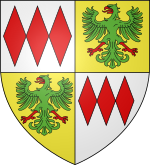Baron Montagu of Boughton is a British title which has been created twice for members of the Noble House of Montagu. First created in 1621, in the Peerage of England, for Sir Edward Montagu, eldest son of Sir Edward Montagu of Boughton[1] and grandson of another Sir Edward Montagu who had been Lord Chief Justice during the reign of Henry VIII. He was also the brother of Henry Montagu, later created Earl of Manchester, and of Sidney Montagu, ancestor of the Earls of Sandwich.[2]
Their ancestor was one Richard Ladde, grandfather of the Lord Chief Justice Sir Edward, who changed his name to Montagu in about 1447. His descendants claimed a connection with the main house of Montagu or Montacute, Barons Montagu and Earls of Salisbury, but the exact descent is unclear. A case has been made out for the possibility that the Ladde alias came from a division among coheirs about 1420 of the remaining small inheritance of a line of Montagus at Spratton and Little Creton, also in Northamptonshire.[3]
The third Baron Montagu of Boughton was created Earl of Montagu and Viscount Monthermer in 1689 and Duke of Montagu and Marquess of Monthermer in 1705.[1][4] He had married in 1675 the Lady Elizabeth Wriothesley, daughter of the 4th Earl of Southampton[4] and a descendant of the original houses of Montagu and Monthermer.[citation needed] The Dukedom, Earldom and Barony of Montagu all became extinct on the death of their son John, 2nd Duke of Montagu, in 1749.[1][4] The next creation was in 1762, in the Peerage of Great Britain. John Montagu, styled Lord Brudenell, son of the 4th Earl of Cardigan and maternal grandson of the last Duke of Montagu, was created Baron Montagu of Boughton in 1762. This title became extinct on his death without issue in 1770.[5]
The next creation was for the late Baron's father, who had been created Duke of Montagu in 1766. He was created Baron Montagu of Boughton, again in the Peerage of Great Britain, in 1786. On his death in 1790, when the Dukedom became extinct, the Barony passed under a special remainder to his female-line grandson Lord Henry Scott, second son of the 3rd Duke of Buccleuch.[6][7] Lord Henry Scott also inherited the Lordship of Bowland from his mother, the Duchess, having the title entailed upon him by his nephew, the 5th Duke, in 1827.[citation needed] He died in 1845 whereupon the title of Montagu of Boughton became extinct.[6]
His great-nephew Lord Henry Douglas-Scott-Montagu, second son of the 5th Duke of Buccleuch, was created Baron Montagu of Beaulieu in 1885.[8][9]
- ^ a b c Montagu, Baron (E, 1621 – 1749) at Cracroft's Peerage. Accessed 1 January 2014.
- ^ Manchester, Earl of (E, 1625/6) Archived 2014-01-02 at the Wayback Machine at Cracroft's Peerage. Accessed 1 January 2014.
- ^ Wagner, Anthony (1960). English Genealogy. Oxford: Oxford University Press. ISBN 9780712667241.
The explanation of a fifteenth century yeoman's Norman name might sometimes be female descent from a knightly house through a coheir. The Montagus of Boughton, Northhamptonshire, who acquired a barony in 1621, an earldom in 1689, the dukedom of Montagu in 1705, and in their younger branches the earldom of Manchester in 1626, the dukedom of Manchester in 1719, and the earldom of Sandwich in 1660, descended from Richard Montagu alias Ladde, a yeoman or husbandman, living in 1471 at Hanging Houghton, Northamptonshire, where the Laddes had been tenants since the fourteenth century. Alias names, in some respect the forerunners of modern compound (or double-barreled) name, were common in the Middle Ages. In the earliest times, when surnames were new, an alias may just mean indecision between equally attractive alternatives. Later they sometimes indicate bastardy (one name perhaps being the father's and one the mother's), but in most cases probably mark inheritance through an heiress whose name was thus perpetuated. A good case has been made out for the possibility that the Ladde alias came from a division among coheirs about 1420 of the remaining small inheritance of a line of Montagus at Spratton and Little Creton, also in Northamptonshire. This line was of knightly origin and probably a branch of the baronial Montagus (Earls of Salisbury from 1337), whose almost certain ancestor Dru de Montagud was a tenant-in-chief in 1086. Other yeoman Montagus are found in Buckinghamshire from 1354 when Roger Montagu appears as a witness to a quitclaim of land in Great Kimble, notably in Halton where a family of Montagu alias Elot held land from about 1440 to 1610. A line of Montagus found in Waddesdon from about 1540 may have branched from these. These in the eighteenth century were shepherds and drovers and one set up in Aylesbury as a wheelwright and another as a tailor. Another line, also possibly branched from Halton, is found at Boveney and Dorney in the sixteenth and seventeenth centuries. This produced Richard Montagu, Bishop of Chichester (1628–38) and Norwich (1638–41), and Peter Montagu, who settled in Virginia.
- ^ a b c Montagu, Duke of (E, 1705 – 1709) Archived 2019-02-25 at the Wayback Machine at Cracroft's Peerage. Accessed 1 January 2014.
- ^ Montagu of Boughton, Baron (GB, 1762 – 1770) at Cracroft's Peerage. Accessed 1 January 2014.
- ^ a b Montagu of Boughton, Baron (GB, 1786 – 1845) at Cracroft's Peerage. Accessed 1 January 2014.
- ^ Montagu, Duke of (GB, 1766 – 1790) at Cracroft's Peerage. Accessed 1 January 2014.
- ^ Buccleuch, Duke of (S, 1663) Archived 2013-10-19 at the Wayback Machine at Cracroft's Peerage. Accessed 1 January 2014.
- ^ Montagu of Beaulieu, Baron (UK, 1885) at Cracroft's Peerage. Accessed 1 January 2014.



